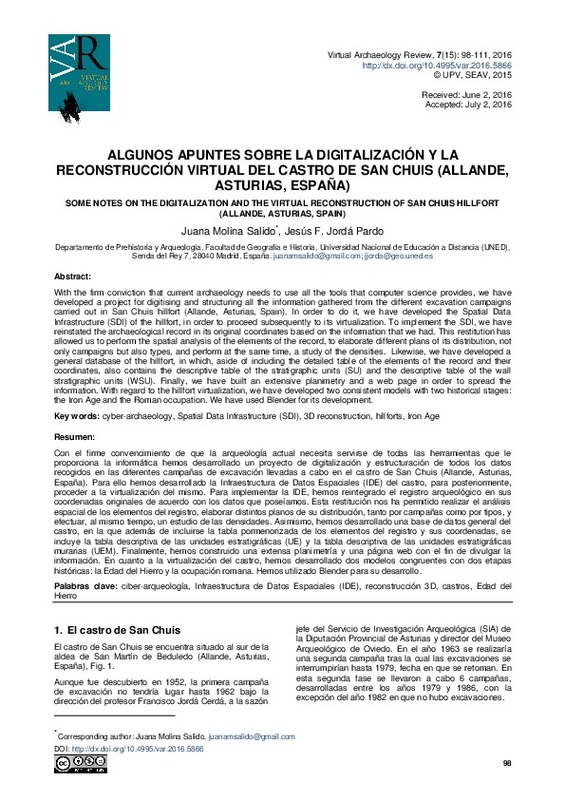|
Resumen:
|
[EN] With the firm conviction that current archaeology needs to use all the tools that computer science provides, we have developed a project for digitising and structuring all the information gathered from the different ...[+]
[EN] With the firm conviction that current archaeology needs to use all the tools that computer science provides, we have developed a project for digitising and structuring all the information gathered from the different excavation campaigns carried out in San Chuis hillfort (Allande, Asturias, Spain). In order to do it, we have developed the Spatial Data Infrastructure (SDI) of the hillfort, in order to proceed subsequently to its virtualization. To implement the SDI, we have reinstated the archaeological record in its original coordinates based on the information that we had. This restitution has allowed us to perform the spatial analysis of the elements of the record, to elaborate different plans of its distribution, not only campaigns but also types, and perform at the same time, a study of the densities. Likewise, we have developed a general database of the hillfort, in which, aside of including the detailed table of the elements of the record and their coordinates, also contains the descriptive table of the stratigraphic units (SU) and the descriptive table of the wall stratigraphic units (WSU). Finally, we have built an extensive planimetry and a web page in order to spread the information. With regard to the hillfort virtualization, we have developed two consistent models with two historical stages: the Iron Age and the Roman occupation. We have used Blender for its development.
[-]
[ES] Con el firme convencimiento de que la arqueología actual necesita servirse de todas las herramientas que le proporciona la informática hemos desarrollado un proyecto de digitalizacióny estructuración ...[+]
[ES] Con el firme convencimiento de que la arqueología actual necesita servirse de todas las herramientas que le proporciona la informática hemos desarrollado un proyecto de digitalizacióny estructuración de todos los datos recogidos en las diferentes campañas de excavación llevadas a cabo en el castro de San Chuis (Allande, Asturias, España). Para ello hemos desarrollado la Infraestructura de Datos Espaciales (IDE) del castro, para posteriormente, proceder a la virtualización del mismo. Para implementar la IDE, hemos reintegrado el registro arqueológico en sus coordenadas originales de acuerdo con los datos que poseíamos. Esta restitución nos ha permitido realizar el análisis espacial de los elementos del registro, elaborar distintos planos de su distribución, tanto por campañas como por tipos, y efectuar, al mismo tiempo, un estudio de las densidades. Asimismo, hemos desarrollado una base de datos general del castro, en la que además de incluirse la tabla pormenorizada de los elementos del registro y sus coordenadas, se incluye la tabla descriptiva de las unidades estratigráficas (UE) y la tabla descriptiva de las unidades estratigráficas murarias (UEM). Finalmente, hemos construido una extensa planimetría y una página web con el fin de divulgar la información. En cuanto a la virtualización del castro, hemos desarrollado dos modelos congruentes con dos etapas históricas: la Edad del Hierro y la ocupación romana. Hemos utilizado Blender para su desarrollo.
[-]
|








